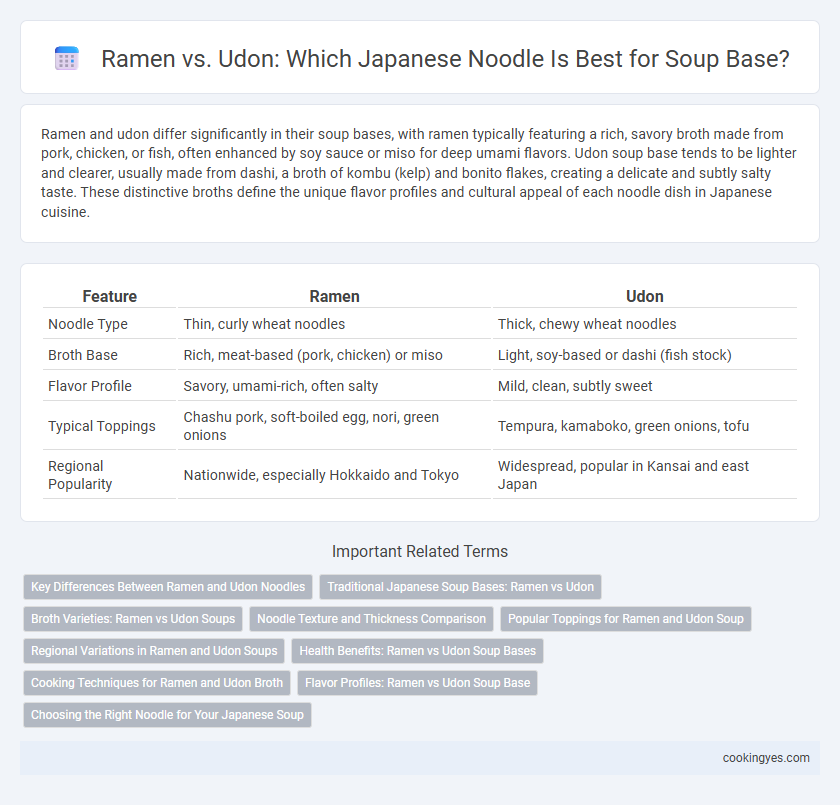Ramen and udon differ significantly in their soup bases, with ramen typically featuring a rich, savory broth made from pork, chicken, or fish, often enhanced by soy sauce or miso for deep umami flavors. Udon soup base tends to be lighter and clearer, usually made from dashi, a broth of kombu (kelp) and bonito flakes, creating a delicate and subtly salty taste. These distinctive broths define the unique flavor profiles and cultural appeal of each noodle dish in Japanese cuisine.
Table of Comparison
| Feature | Ramen | Udon |
|---|---|---|
| Noodle Type | Thin, curly wheat noodles | Thick, chewy wheat noodles |
| Broth Base | Rich, meat-based (pork, chicken) or miso | Light, soy-based or dashi (fish stock) |
| Flavor Profile | Savory, umami-rich, often salty | Mild, clean, subtly sweet |
| Typical Toppings | Chashu pork, soft-boiled egg, nori, green onions | Tempura, kamaboko, green onions, tofu |
| Regional Popularity | Nationwide, especially Hokkaido and Tokyo | Widespread, popular in Kansai and east Japan |
Key Differences Between Ramen and Udon Noodles
Ramen noodles are thin, curly, and made from wheat flour with alkaline water, giving them a firm texture and yellowish hue, which pairs well with rich, savory broths like miso or tonkotsu. Udon noodles are thick, smooth, and chewy, made from wheat flour without alkaline additives, making them ideal for lighter, clear soup bases such as dashi. The key differences lie in texture, thickness, and preparation, influencing the overall taste and mouthfeel of Japanese soups.
Traditional Japanese Soup Bases: Ramen vs Udon
Traditional Japanese soup bases for ramen and udon differ significantly in flavor and preparation, with ramen typically using a rich, savory broth made from pork, chicken, or fish combined with soy sauce or miso, resulting in a complex umami profile. Udon soup base, called kakejiru, features a lighter, clearer dashi stock primarily made from kombu (kelp) and katsuobushi (bonito flakes), emphasizing delicate flavors that complement the thick wheat noodles. These distinct broths showcase regional variations and culinary techniques fundamental to authentic Japanese noodle soups.
Broth Varieties: Ramen vs Udon Soups
Ramen broth typically features a rich, umami-packed base made from pork, chicken, or fish, often enhanced with soy sauce, miso, or salt for depth. Udon broth, known as kakejiru, is lighter and clearer, usually crafted from dashi stock derived from kombu seaweed and katsuobushi flakes, emphasizing subtle, delicate flavors. The contrasting broth varieties highlight ramen's hearty, complex taste versus udon's clean, soothing profile, shaping each noodle soup's unique culinary experience.
Noodle Texture and Thickness Comparison
Ramen noodles feature a firm and chewy texture with a thinner, straighter shape that allows them to absorb rich, oily soup bases effectively. Udon noodles are thicker and softer, offering a smooth, slippery bite that complements lighter, clear broths by balancing texture with subtle flavor. The contrast in thickness and mouthfeel significantly influences how each noodle interacts with Japanese soup bases, enhancing distinct dining experiences.
Popular Toppings for Ramen and Udon Soup
Ramen soup often features toppings like chashu pork, soft-boiled eggs, menma bamboo shoots, and green onions, enhancing its rich, savory broth made from pork, chicken, or miso. Udon soup typically includes toppings such as tempura, kamaboko fish cakes, scallions, and wakame seaweed, complementing its mild dashi-based broth made from kombu and bonito flakes. The choice of toppings significantly influences the flavor profile and texture, distinguishing the hearty, robust taste of ramen from the delicate, soothing nature of udon.
Regional Variations in Ramen and Udon Soups
Ramen soups vary regionally from Sapporo's rich miso base to Hakata's creamy tonkotsu broth, each reflecting local ingredients and climate. Udon soups also exhibit regional differences, with Kagawa favoring light soy-based broths and Akita offering more robust, seafood-infused stock. These regional variations influence noodle texture and soup flavor, highlighting Japan's diverse culinary landscape.
Health Benefits: Ramen vs Udon Soup Bases
Ramen soup bases often contain higher sodium levels and rich, fatty broths like tonkotsu, impacting cardiovascular health if consumed frequently. Udon soup bases, typically made from lighter dashi broth with ingredients such as kombu and bonito flakes, offer lower fat content and milder sodium levels, supporting better heart health and digestion. Choosing udon over ramen can promote reduced calorie intake and improved hydration due to its clearer, less oily broth composition.
Cooking Techniques for Ramen and Udon Broth
Ramen broth typically requires long hours of simmering pork bones, chicken, and vegetables to develop a rich umami flavor, often enhanced with soy sauce or miso. Udon broth, also called dashi, relies on quick extraction of flavors from kombu seaweed and katsuobushi (bonito flakes), emphasizing a lighter, clearer soup base. The distinct cooking techniques reflect ramen's hearty and complex profile versus udon's subtle and delicate broth essence.
Flavor Profiles: Ramen vs Udon Soup Base
Ramen soup base is known for its rich, complex flavors derived from ingredients like pork bones, soy sauce, miso, or seafood, creating a savory umami depth that intensifies with simmering. Udon broth, typically made from dashi--a blend of kombu seaweed and bonito flakes--offers a lighter, subtly sweet and clean taste that highlights delicate flavors rather than overwhelming the palate. The contrast between ramen's hearty, bold savoriness and udon's mild, refined broth defines their unique flavor profiles in Japanese cuisine.
Choosing the Right Noodle for Your Japanese Soup
Ramen noodles are thin and curly, perfectly absorbing the rich, savory flavors of tonkotsu or miso-based broths, making them ideal for hearty, intense Japanese soups. Udon noodles are thick, chewy, and less porous, better suited for lighter, clearer broths such as kake or dashi, providing a satisfying texture without overpowering subtle flavors. Selecting between ramen and udon depends on the soup base's strength and desired mouthfeel, ensuring a balanced and authentic Japanese noodle experience.
Ramen vs Udon for Japanese soup base Infographic

 cookingyes.com
cookingyes.com